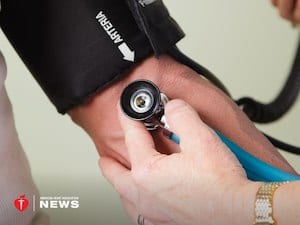
TUESDAY, May 1, 2018 (American Heart Association) — Blood pressure readings taken outside of the doctor’s office often read higher than those in the office, a new study says.
Spanish researchers found that 39 percent of people who had normal blood pressure readings at the doctor registered high blood pressure readings out of the office over a 24-hour period when using American Heart Association/American College of Cardiology treatment guidelines.
The researchers found that 20 percent had high blood pressure when doing out-of-office readings under European blood pressure criteria.
The phenomena of people registering normal at the doc but higher at home or the office is called “masked hypertension.” The AHA/ACC and European guidelines both warn of the dangers of the condition and the need for improved treatment.
Masked hypertension comes with stark implications because it isn’t diagnosed by a routine medical examination and brings an adverse prognosis of organ damage or heart disease, stroke or other cardiovascular diseases if it continues to go unrecognized.
Cardiovascular disease has been the leading cause of death in the United States for more than half a century. From 2005 to 2015, the death rate attributable to high blood pressure increased by about 10 percent.
Males, younger people who are active or those with additional cardiovascular risk factors are most at risk for high blood pressure that isn’t apparent at the doctor’s office, according to the study published April 30 in the American Heart Association journal Circulation.
High blood pressure is defined as a systolic pressure of 130 or above, or a diastolic pressure of 80 or above, according to AHA/ACC treatment guidelines. The target guideline from the European Society of Hypertension and the European Society of Cardiology is generally 140/90.
Among people treated for high blood pressure, masked hypertension “is often seen in those who seem apparently controlled, but signs of silent organ damage are still present,” said study author Dr. Alejandro de la Sierra. He heads the Internal Medicine Department at Hospital Mutua Terrassa at the University of Barcelona in Spain.
The high prevalence of masked hypertension was observed in the study of 115,708 people who were monitored for 24 hours using devices. Their blood pressure was measured every 20 minutes during the day and every 30 minutes at night. Those in the study are part of the Spanish Ambulatory Blood Pressure Measurements registry.
The study supports a wider use of blood pressure monitoring at regular intervals in routine clinical practice. Both guidelines recommend such screening for masked hypertension for people who are at risk.
The possible barriers to doing that include out-of-pocket costs, test accuracy and instruction time.
But the payoff is there, said Dr. Willie Lawrence, an interventional cardiologist for Midwest Heart and Vascular Specialists at Research Medical Center in Kansas City, Mo. Lawrence recommends 24-hour monitoring, which is more widely applicable than other types of blood pressure monitoring.
“Twenty-four-hour monitoring is a great research tool and it’s very valuable in select clinical situations. It allows us to better understand how to use more basic tools to detect and treat large populations under various circumstances,” he said.
Dr. Robert Eckel, an endocrinologist and physician-scientist at the University of Colorado Anschutz Medical Campus, agreed that more measurements provide more insight.
“Ambulatory measurements are valuable but should be performed carefully using the right equipment and if possible under optimal conditions,” he said. “Moreover, 24-hour assessments are always better than one to three measurements per day.”
